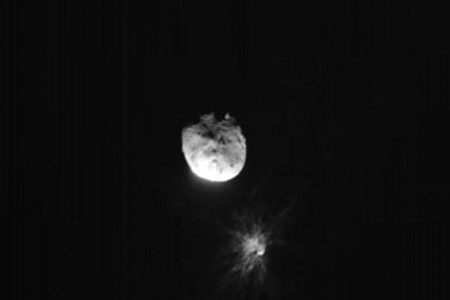2023 DW, confirmed February 28, has a one in 560 chance of impact on February 14 at 4:44 pm ET - but where it will fall is not yet known.
The predicted impact zones stretch from the Indian Ocean to the Pacific Ocean and the west to the east coast of the US - with Los Angeles, Hawaii and Washington DC as possibilities.
The collision of the 165-foot 2023 DW with our planet would be comparable to the Tunguska 12-megaton event that slammed into Siberia 114 years ago.
This 160-foot asteroid caused a nuclear explosion that would have destroyed a large metropolitan area - but it landed in a forest, flattening more than 80 million trees.
NASA announced the discovery of 2023 DW on Tuesday, noting that it 'takes several weeks of data to reduce the uncertainties and adequately predict their orbits years into the future.'
The probability of the asteroid hitting Earth has changed over the past week.
On March 1, an Italian astronomer shared NASA showed a one in 1,2000 chance, but the odds increased a day later to one in 710 - and now there is a one in 560.
As of March 7, 2023, the analysis of its orbit was just 62 observations spanning 6.8487 days through March 4, 2023.
2023 DW is currently at the top of NASA's Risk List with a 1 on the Torino scale – meaning there is no cause for public concern at this time.
'A routine discovery in which a pass near the Earth is predicted that poses no unusual level of danger,' reads the description on the Torino scale.
'Current calculations show the chance of collision is extremely unlikely with no cause for public attention or public concern. New telescopic observations very likely will lead to re-assignment to Level 0.'
'Orbit analysts will continue to monitor asteroid 2023 DW and update predictions as more data comes in,' NASA tweeted.
While 2023 DW sits at 1, it could reach 10, labeled 'Certain Collisions.'
'A collision is certain, capable of causing global climatic catastrophe that may threaten the future of civilization as we know it, whether impacting land or ocean,' reads the description.
'Such events occur on average once per 100,000 years, or less often.'
However, NASA notes it would alert the public if 2023 DW reaches 3 on the scale.
The last significant impact was on February 15, 2013, known as Chelyabinsk.
A 60-foot-wide meteor hit the Earth's atmosphere with energy estimated to be equivalent to 500,000 tons of TNT, sending a shockwave twice around the globe.
It caused widespread damage and injured more than 1,600 people.
And 2023 DW is more than twice the size.
NASA recently confirmed it can deflect a killer asteroid off a path toward Earth, following its successful DART mission in 2021.
The agency launched its Double Asteroid Redirection Test (DART) in 2022 for humanity's first planetary defense mission, dubbed NASA's 'Armageddon moment.'
The craft's target was a moonlet called Dimorphos circling its parent asteroid, Didymos.
On September 26, the world watched as DART soared 15,000 miles per hour toward Dimorphos to push it off its orbit.
And on March 1, 2023, NASA confirmed the mission was a smashing success.
The space agency's refrigerator-sized satellite managed to shave 33 minutes off the orbit of a 520-foot-wide asteroid - nearly five times greater than what was predicted.
Scientists from the Northern Arizona University said: 'This serves as a proof-of-concept for the kinetic impactor technique of planetary defense, DART needed to demonstrate that an asteroid could be targeted during a high-speed encounter and that the target's orbit could be changed.' (Daily Mail)


